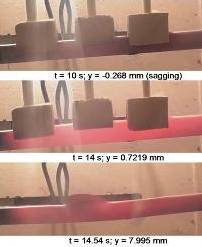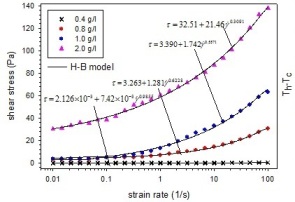Flow boiling in microchannels
In recent years, power density in electronic devices has been drastically raised due to increase in system's operating frequency, interconnect resistance, package densities and decrease in physical size of the components. This has lead to high heat generation in the device and quickly reaching a high temperature which cannot be cooled down by present package-level cooling techniques using air as coolant. Liquid coolant flow through microchannles or microchannels as heat sinks has emerged as feasible solution for such problems. One of the advantages of microchannels as heat sinks is higher heat transfer rate due to high surface to volume ratio. Besides higher heat transfer rate they are also compact and can be fabricated inside a physical size of chips. Further two-phase evaporative flow or flow boiling in microchannels is more effective than the single phase flow due to involvement of latent heat in the process. High heat removal using low coolant flow rate and temperature uniformity in the channels are two favourable characteristics of two-phase cooling technique. However during flow blowing, growing bubbles restrict the flow of coolant in confined microchannels and impose the back flow of the coolant. This results the increase and fluctuation of temperature, pressure causing instability and poor heat transfer. Efforts have been made by our group to reduce the flow instability by incorporating geometric modifications of the microchannels. Two-geometric variations i.e. diverging and segmented finned microchannels are experimentally investigated for reducing flow boiling instability in microchannels.
In parallel with experimental work, development of analytical/numerical model for investigating bubble growth and bubble dynamics in flow boiling, are in progress.

Bursting Characteristics of Fuel Clad for Nuclear Safety
In nuclear reactor, fuel clad is a thin cylindrical tube used to house fuel (uranium) pellets and to safely carryout nuclear fission reaction in pressurized heavy water reactors (PHWR). Zircaloys, a class of zirconium alloys, are extensively used as cladding materials. In normal operation of nuclear reactor fuel clad receives sufficient amount of coolant to keep the clad tube temperature within limits. However, in an accident scenario, the coolant supply gets affected, which leads to drastic rise in clad surface temperature and with the failure of emergency core cooling system, fuel clad undergoes ballooning followed by bursting. Bursting characteristics data of fuel clad are important for safety operation of nuclear reactors. In SERL an extensive burst investigation has been carried out on zircaloy-4 claddings in an inert environment to simulate clad burst during a postulated loss-of-coolant-accident (LOCA) conditions. A generalized burst criterion has been developed and semi-empirical correlation has been developed to predict the burst stress for a given burst temperature.
Another investigation on effect of hydrogen ingress or hydride formation in bursting of Zircaloy fuel claddings is underway. Diffusion of hydrogen in Zircaloy during its service time severely affects its several properties such as dimensional stability, mechanical strength, its corrosion and creep behaviour etc. Analysis of hydrogen embrittlement and subsequent burst characteristics of Zircaloy-4 fuel clad is in progress.
 |
 |
|
Thermorheological Behavior of Viscoplastic Fluids
Viscoplastic fluids are special kind of non-Newtonian fluids which behave like solids under applied stress below a critical stress known as yield stress. They behave like fluids once applied stress exceeds yield stress. Convection in viscosplastic fluids has scientific relevance owing to its widespread applications ranging from food, chemical and cosmetic industries to natural phenomena like flow of lava and mud. The heat transfer mechanism in these processes affects the temperature distribution and evolution of yielded zones which in turn control the qualities like appearance, taste and durability of final products. Both experimental and numerical investigations on natural convection of viscoplastic fluids for different boundary conditions have been performed. Thermorheological characterization of viscoplastic gels and their behaviour in Rayleigh-Benard convection have been investigated. Numerical models with thermorheological data have been developed. Investigations have facilitated the understanding of thermal instability, onset of convection, evolving shape and size of yielded and unyielded zones, existence of sharp boundary between yielded and unyielded regions and movement of plugged region etc.
 |
 |
|
Solar Thermal Technology and Thermal Storage System
Technologies used to harness solar energy have emerged as the most promising and mature since solar energy is abundant, freely available, and it has commercial potential too. The geographical location of India is quite suitable for harvesting the true potential of solar energy. Different designs of solar collectors are being investigated in order to achieve the optimal performance.
 |
 |
|
Two portable collectors (concentrated parabolic and flat plate) have been fabricated and experiments are conducted to evaluate their performances. Development of single axis solar tracking system and solar thermal storage system are going on. Further numerical investigation on heat transfer enhancement in solar air heater with artificially roughened absorber plate has been carried out.
Dispersion of droplets and bubbles at micro scales
Droplets and bubbles are ubiquitous in nature and form the basis of two-phase flow. In a two-phase flow, droplets formation results the creation of new surfaces which enhance heat and mass transfer and the phenomenon has been a basis of wide ranges of phase-contact applications involving liquid-in-gas systems (e.g. atomization and sprinkling) and liquid-in-liquid system (e.g. liquid-liquid extraction and emulsions). Droplet formation and breakup are observed in several applications such as mixing in multiphase systems, blending of molten polymers, ink-jet printers, deformation of biological cells, atmospheric rain drop formation etc. On the other dispersion of liquid droplets in another liquid in micro scales is termed as emulsions. Different numerical models using finite volume and boundary integral method are developed to investigate growth and dispersion of bubbles and droplets in two-phase flow system.

